Dere Street
Dere Street or Deere Street is a modern designation of a Roman road which ran north from Eboracum (York), crossing the Stanegate at Corbridge (Hadrian's Wall was crossed at the Portgate, just to the north) and continuing beyond into what is now Scotland, later at least as far as the Antonine Wall. Portions of its route are still followed by modern roads, including the A1 (south of the River Tees), the B6275 road through Piercebridge, where Dere Street crosses the River Tees, and the A68 north of Corbridge in Northumberland.
| Dere Street | |
|---|---|
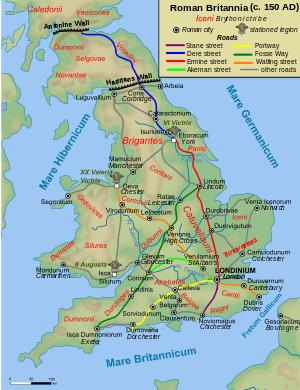 Route of Dere Street in blue | |
| Route information | |
| Length | 226 mi (364 km) [146 mi or 235 km Eboracum to Trimontium; 80 mi or 129 km Trimontium to Veluniate] |
| Time period | Roman Britain Saxon Britain Norman Britain |
| Major junctions | |
| From | Eboracum |
| Isurium, Cataractonium, Morbium, Vinovium, Longovicium, Vindomora, Coria, Onnum, Habitancum, Bremenium, Trimontium, Inveresk, Cramond | |
| To | Veluniate |
Name
The Roman name for the route is lost. Its English name corresponds with the post-Roman Anglo-Saxon kingdom of Deira, through which the first part of its route lies. That kingdom possibly took its name from the Yorkshire River Derwent. The term "street" derives from its Old English sense (from Latin: via strata), which referred to any paved road and had no particular association with urban thoroughfares.
Portions of the road in Scotland were later known as St Cuthbert's Way and as the Royal Way (Medieval Latin: Via Regia).
"Watling Street"
The Roman equivalent of Watling Street, the Antonine Itinerary's 2nd British route, shared Dere Street's trunk road between Eboracum and Cataractonium (Catterick) before branching off to the northwest to communicate with Luguvalium (Carlisle). Owing to this, some stretches or the entirety of Dere Street is sometimes referenced as "Watling Street", a name that appears on the 1885-1900 edition of the Ordnance Survey map for the village of Oxnam[1]. A small section of the old A68 route north in Corbridge is called Watling Street[2]. It should not, however, be confused with the traditional route between Canterbury and Wroxeter in the south nor with the Carlisle route to its west.

Roman route
As far as Hadrian's Wall Dere Street roughly corresponds to the Antonine Itinerary's 1st British route, which however began further south than York and ended at the Wall:[3][4]
| From the border—that is, from the Wall—unto Praetorium, | 156 Roman miles. | |||
|---|---|---|---|---|
| From Bremenium | [Binchester], | Coria [Corbridge], | 20 | |
| To Vindomora | [Ebchester], | 9 | ||
| To Vinovia | [Binchester], | 19 | ||
| To Cataractonium | [Catterick], | 22 | ||
| Isurium | [Aldborough], | 24 | ||
| Eboracum | [York], | 6th Victorious Leg., | 17 | |
| To Derventio | [Malton], | 7 | ||
| To Delgovicia | [unknown], | 13 | ||
| To Praetorium | [unknown], | 25 | ||
As the text implies, the road served to allow the legion garrisoned in York quick access to the eastern borderlands and, later, the eastern posts on Hadrian's Wall. The Itinerary's 2nd and 5th British routes—which split off to reach the western territories—share the stations between Eboracum and Cataractonium. The forts along the roads were manned by infantry cohorts and cavalry alae of the Roman army's auxiliaries.
Margary notes that the last entry 25 (XXV) Roman miles is probably in error and should be emended to 15 (XV) Roman miles.[7]
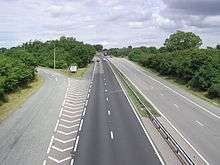
Modern route
The modern route omits the now-lost road south of York[8] but continues farther north along Roman roads either omitted by the compiler of the Antonine Itineraries or constructed after his time.
The route begins at York and crosses the River Ure near Aldborough close to Boroughbridge. It crosses the Swale near Catterick. (The ruins of Cataractonium lie just north of Catterick at Scotch Corner.) The A66 road preserves the route of the Roman-era Watling Street, branching off here to cross Stainmore to Penrith and Carlisle at the western end of Hadrian's Wall.[9]
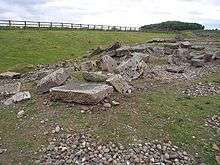
Dere Street crossed the River Tees over a stone arch bridge near the present-day Piercebridge Roman Fort ruins. Such bridges were rare in Roman Britain except for here in the far north.[10] The original bridge was replaced by one on a different alignment.[11] There is evidence of other minor realignments of Dere Street over the Roman period.[11] In 1994, construction of a garage at Cliffe exposed a section of the Roman road and discovered pottery and tile from the period.[12][13] Raymond Selkirk suggested that the ruins on the south side of the Tees at Cliffe are the remains of a jetty;[14] the archaeological television programme Time Team investigated this in 2009.[15]
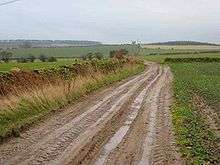
The next river crossing occurred over the Wear near present-day Bishop Auckland.[16] At this point, the fort Vinovia guarded a branch road that turned off to the right heading for Durham, Chester-le-Street, and Newcastle. There, the Pons Aelius crossed the River Tyne.[17]
Dere Street, meanwhile, travels onward past Lanchester and Ebchester, the sites of the former forts of Longovicium and Vindomora. At Coria (modern Corbridge), it met the Stanegate road which runs parallel to Hadrian's Wall.[18] Stanegate and Dere Street were originally the same width (roughly 7.7 m or 25 ft) but the depth of metalling on Stanegate—72 cm (28 in) against Dere Street's 30 cm (12 in)—argues for a greater frequency of resurfacing and for greater or heavier traffic.[19] Crossing at Corbridge, the route passed through Portgate on the Wall and passed into lands only tenuously claimed by Rome.[20]
The route passes north into Redesdale and thence into the Cheviot Hills, where there are the remains of marching forts at Fourlaws, West Woodburn (Habitancum), Rochester (Bremenium), and at Chew Green.[20] Brementium was the last stop listed for Antonine Itinerary, but the Roman road's remains now lead further, past the present Anglo-Scottish border at Carter Fell near the present A68 road. Nearby, there are the remains of a camp at Pennymuir.[21] Further on, well-preserved sections of the road form part of St Cuthbert's Way to Trimontium near Melrose. There, the route crosses the Tweed and follows the Leader Water to the foot of the Lammermuirs, where there is evidence of Roman forts near Oxton. Another well-preserved section rises through the Lammermuirs over Soutra Hill and on to Edinburgh, where Din Eidyn was a stronghold for the British Votadini tribe. Nearby, the Romans held garrisons at Cramond and Inveresk at the eastern end of the Antonine Wall.[22]
History
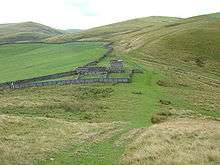
During the High Middle Ages, the section of the route between Jedburgh and Edinburgh was known as the Royal Way (Latin: Via Regia). It connected the larger part of Scotland with the important ecclesiastic sites of the Scottish Borders. King Malcolm IV established his Church and Hospital of the Holy Trinity halfway along this section to provide succour for the many pilgrims using it.[23]
After the destruction of the Border Abbeys during the "Rough Wooing" of Mary, Queen of Scots, by the Earl of Hertford's forces and during the Reformation of the Scottish Church, the route fell into disuse and disrepair. It was used mainly for driving livestock and occasional travellers daring enough to venture into the lawless border region.[24]
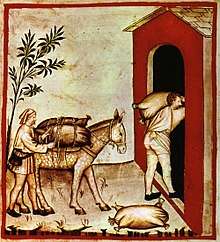
Dere Street continued in use between Durham and York in medieval times. Being limited by daylight, "about thirty miles in a day in winter on horseback and between thirty-six and forty in summer was what a man could do." Tough, vigorous men could walk from Darlington to York, and it was said that the quality of a horse could make the difference between a possible thirty and fifty miles per day. A wish to hear mass or the organisation of a train by the rich could shorten the travelling day to twenty miles. Roads were described as so muddy and difficult between November and February that to finish the journey by daylight one could barely stop to eat; however a "royal highway" or alta via regia strata was passable in winter between York and Durham, and this could have been Dere Street. Heavy packhorse loads were taken on the route, for example 20 stone (130 kg) of wool. Clerics, traders and the nobility were more likely to travel than others, and some people rarely travelled at all. Travelling in style involved the use of carts for luggage, but carts bogged down in winter mud, so traders with packhorses travelled more easily in winter than the rich.[25]
See also
- Piercebridge Roman Bridge
- Roman roads in Britain
Gallery
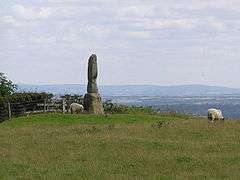 Legg's cross on Dere Street near Bolam in County Durham
Legg's cross on Dere Street near Bolam in County Durham Dere Street at Bildershaw, County Durham
Dere Street at Bildershaw, County Durham Wheelbirks bridge, near Hindley, Northumberland
Wheelbirks bridge, near Hindley, Northumberland Milestone at West Woodburn, Northumberland
Milestone at West Woodburn, Northumberland Dere Street at Bonjedward, Scottish Borders
Dere Street at Bonjedward, Scottish Borders Dere Street at Crailinghall, Scottish Borders
Dere Street at Crailinghall, Scottish Borders Dere Street at Maxton, Scottish Borders
Dere Street at Maxton, Scottish Borders Dere Street at King's Inch[26]. south of Soutra Aisle
Dere Street at King's Inch[26]. south of Soutra Aisle
Notes
- Watling Street,OS One Inch, 1885-1900, National Library of Scotland
- Watling Street, Area Information for Watling Street, Corbridge, NE45 5AG
- Itinerarium Antonini Augusti. Hosted at Latin Wikisource. (in Latin)
- Togodumnus (2011). "The Antonine Itinerary". Roman Britain Online. Archived from the original on 18 September 2015. Retrieved 20 February 2015. (in Latin and English)
- Margary, Ivan Donald (1973). Roman Roads in Britain (3rd ed.). London: John Baker. ISBN 9780212970018.
- Togodumnus (2010). "Praesidivm/Praetorivm? Probable Roman Fort and Port". Roman Britain Online. Archived from the original on 31 October 2014. Retrieved 20 February 2015.
- Margary,[5] cited at Roman Britain Online.[6]
- Davies, Hugh (2002). Roman Roads in Britain. Stroud. pp. 20–21. ISBN 0-7524-2503-X.
- Hayton, Richard (2003). "Yorkshire History.com". Roman military sites in Yorkshire. Retrieved 16 January 2010.
- Davies, p. 93.
- "1".
- "Heritage Gateway". Listed buildings online, and local records. Archived from the original on 25 September 2005. Retrieved 11 January 2010.
- NY SMR Number MNY12855; Old Sites & Monuments Record Number 12975.10000; Grid Reference NZ 212,155; SNY8056 Field recording Form, North Yorkshire County Council 15 November 1994, George Hotel Piercebridge (Dere Street Cottage), Campling, N. NYCC Observation Record
- Selkirk, Raymond (2000). Chester-le-Street & Its Place in History. Birtley, County Durham: Casdec Print & Design Centre. pp. 93–122. ISBN 1-900456-05-2.
- Lloyd, Chris (2 July 2009). "The Northern Echo". Piercebridge: Time Team investigates. Archived from the original on 27 September 2012. Retrieved 12 January 2010.
- Laurie, Barbara (2005). "bishopaucklandhistory.co.uk". A Short History of Bishop Auckland. Retrieved 16 January 2010.
- "Pastscape, English Heritage". Dere Street Investigation History. Publications : Full report Proceedings of the Society of Antiquaries of Newcastle upon Tyne 2/1925/12:94-6. Archived from the original on 24 December 2012. Retrieved 16 January 2010.CS1 maint: location (link)
- Bishop, M.C. "Durham.ac.uk resources" (PDF). Corbridge (archaeological resources). Archived from the original (PDF) on 11 December 2009. Retrieved 16 January 2010.
- Davies, p. 57.
- "BBC". Dere Street – From York to Melrose in Seven Days. 10 June 2009. Retrieved 16 January 2010.
- "Pennymuir camps under snow".
- "Historic Scotland". Dere Street Roman Road. Retrieved 16 January 2010.
- Hunter, James, FSA (Scot)., Fala and Soutra, including a History of the Ancient "Domus de Soltre", Edinburgh, 1892.
- Scotways.com. "Heritage Paths". Dere Street. Retrieved 16 January 2010.
- Harvey, Margaret M. (March 2005). "Travel from Durham to York (and back) in the fourteenth century" (PDF). Northern History. Durham University Library. 1 (XLII): 119–130. Retrieved 16 January 2010.
- King's Inch, OS 1:10,560, Series 1949-1969,National Library of Scotland
Further reading
- The Roads of Mediaeval Lauderdale, by R. P. Hardie, Edinburgh & London, 1942.
External links
| Wikimedia Commons has media related to Dere Street. |
